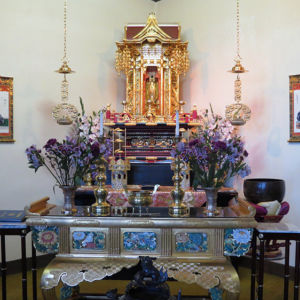If you have never been to a Buddhist temple, do not be intimidated.
It is a welcoming place open to all! Following are some standard practices and traditions that may help you feel more comfortable:

Entering the Temple
Please enter the main shrine area (Hondo) quietly and with dignity. Typical practice is to enter the shrine room with your left foot and bow slightly. We are bowing to show our respect for our teacher who has compassionately shown us the way out of suffering. The bow for entering the shrine area is done by bowing about 15 degrees.
Service books and pamphlets are available to the left of the entrance, please take a blue book, a white 3-ring binder, and any other materials that are provided for the service.
Meditation Service
This service, typically 10:00 – 10:30am, is offered as an opportunity to calm the mind and be fully present. If you arrive after the start of the service please enter quietly and respectfully to avoid disturbing the space or those who are engaged in meditation.
Sensei (“teacher”, or literally, “one who has walked before”) typically provides some teaching and instruction on meditation. If you come from another tradition, you may simply sit in the peace we hope to share with you during your time with us.
Main Service
An appointed chairperson will lead the main service (typically 10:30 – 11:30am). Singing and chanting is done in unison. Since many chants are still in traditional Sino-Japanese, the sound, rather than the specific meaning of the words, is the main experience to be gained. Translations of chants are available on this site if you are interested in learning more.
You will often see people with their hands together in front of their heart at 45 degrees. This is called Gassho (literally, “joined palms”). At the same time, we will often say,” Namo Amida Butsu”. Amida is a reference to Amitabha – the Buddha of Infinite Life (wisdom) and Amitayus – the Buddha of Infinite Life (compassion). Buddha in this chant refers to the Ultimate Reality. The chant, as a statement, declares that we are entrusting ourselves to the Ultimate Reality of infinite light and infinite life. “Light” in Buddhism represents wisdom, while ” Life” represents compassion.
Toward the end of the service we participate in the burning of incense (oshoko). Offering incense is a practice of humility and respect. It an expression of thankfulness and gratitude for the Buddha (Ultimate Reality of Infinite Light and Life). Incense is also associated with purity. Burning incense reminds us to practice pure thoughts, pure speech and pure conduct. Since like the incense, our life is temporary, we need to live a life of gratitude. This practice involves standing in front of the incense burner facing the altar (onaijin).
Then taking one step forward and bowing in the same manner as when you entered the temple. Walk to the incense burner leading with your left foot. When able to reach the incense burner, pinch a small amount of incense and drop it onto the burning coals. Bring your hands together (gassho) with a bow to the altar (onaijin), then take one step back with your right foot, and bow again. Turn and walk back to your seat.
Burning incense as an expression of gratitude is also an opportunity to donate to the temple. Please know that donations are not required to participate in services or in burning incense.
Leaving the Temple
As you leave the main shrine area, the practice is to bow as you did when entering. To do so, you lead with your right foot as you leave (left foot in, right foot out). The left foot represents our humanity and relative understanding of reality, while the right foot represents the ultimate or non-dual reality. The practice is to enter as yourself and leave as yourself – only with a more open heart-mind to the wisdom-compassion in your life.
After the service, please join us for some refreshments and friendly conversation!
Please ask any questions. A core teaching of the Shin Buddhist tradition is seeking truth. Thank you for visiting this site of fellow seekers.

